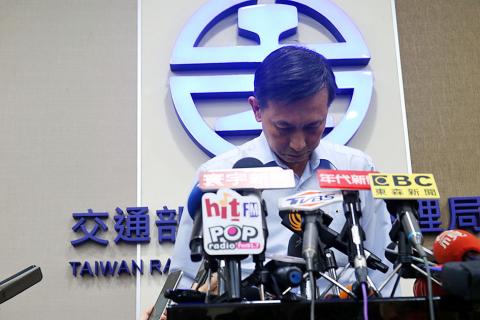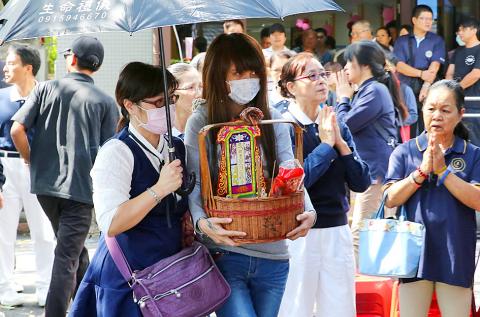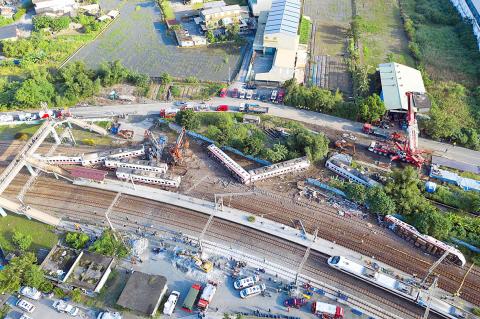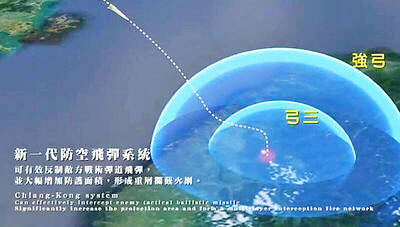The Cabinet yesterday established a task force to investigate Sunday’s deadly train accident in Yilan County.
The 15-member task force is led by Minister Without Portfolio Wu Tze-cheng (吳澤成), while Bureau of High Speed Rail Director-General Allen Hu (胡湘麟) serves as executive secretary and spokesman, Cabinet spokeswoman Kolas Yotaka said.
The task force yesterday visited the accident site and held its first meeting to establish the direction of the investigation, she said, adding that in keeping with a directive from Premier William Lai (賴清德), it would check all Puyuma Express trains to determine whether the service should be suspended.

Photo: AP / Presidential Office
The Taiwan Railways Administration’s (TRA) Safety and Investigation Committee and the Ministry of Transportation and Communications’ Railway Bureau are also investigating.
The TRA yesterday clarified that 190 passengers had been injured in the derailment of Puyuma Express No. 6432 on Sunday afternoon, but three later died in hospital.
TRA Chief Secretary Dennis Ju (朱來順) told a news conference at Taipei Railway Station that 18 passengers were killed and 190 were injured, and the TRA has offered NT$100,000 (US$3,234) to the families of the deceased and NT$5,000 to those who were injured as comfort funds.

Photo: CNA
Families of the deceased would also receive compensation of up to NT$5.3 million per person, while passengers who sustained serious injuries would receive up to NT$2.4 million in compensation, Ju said.
Passengers who suffered more minor injuries would be compensated up to NT$600,000, he said.
Two-way operations were resumed along the east coast at 5:12am yesterday using one railway track, the agency said, adding that trains passing the section of track where the derailment occurred would have to reduce their speed to 40kph.

Photo: Eason Lam, Reuters
The agency is aiming to resume normal operations within three days, as instructed by President Tsai Ing-wen (蔡英文), Ju said.
However, repairing the damage caused by the accident would take time, as electric cables and utility poles at Sinma Train Station (新馬站) were damaged.
Local media yesterday said surveillance camera images showed the train appeared to be traveling at a high speed on Sunday, and some questioned whether the Automatic Train Protection (ATP) system — which should be activated when a train is moving too fast — was working.

Photo: Daniel Shih, AFP
Questions have also been raised about whether the train driver, surnamed Yu (尤), had enough experience to handle an emergency situation, but Ju said You was an experienced driver with five years experience and was deputy head of the Cidu (七堵) operation section.
No driver would be promoted to such a post without extensive experience and a good performance record, he said.
A train driver can decide if the ATP on the train should be turned off, but they must inform the TRA’s dispatch and distribution office in advance so that all train stations could be notified, he said.
Prosecutors have the ATP and the TRA has been instructed not to tamper with evidence, Ju said.
TRA Rolling Stock Department Deputy Director Lai Suei-chin (賴隨金) said that Yu had reported several times on Sunday that the air compressor for the air brake was not always producing enough air pressure.
However, reduced air pressure should cause a train to slow down or stop, not speed up, and it would also not lead a driver to deactivate the ATP, Lai said.
A Puyuma Express train can operate at speeds from 75kph to 85kph when passing through a curve, he said.
The TRA inspected the ATP on trains every day, and the one on No. 6432 was working properly before the train departed from Shulin (樹林) on Sunday, he said.
TRA Director-General Jason Lu (鹿潔身) said the agency suspects that the derailment was caused by the ATP being shut down, but it has yet to verify that idea by examining the communication records between the driver and the dispatch and distribution office, and the ATP data.
Lu said he submitted his resignation to Minister of Transportation and Communications Wu Hong-mo (吳宏謀), but he said his current task is to finish handling the accident.

LIMITS: While China increases military pressure on Taiwan and expands its use of cognitive warfare, it is unwilling to target tech supply chains, the report said US and Taiwan military officials have warned that the Chinese People’s Liberation Army (PLA) could implement a blockade within “a matter of hours” and need only “minimal conversion time” prior to an attack on Taiwan, a report released on Tuesday by the US Senate’s China Economic and Security Review Commission said. “While there is no indication that China is planning an imminent attack, the United States and its allies and partners can no longer assume that a Taiwan contingency is a distant possibility for which they would have ample time to prepare,” it said. The commission made the comments in its annual

DETERMINATION: Beijing’s actions toward Tokyo have drawn international attention, but would likely bolster regional coordination and defense networks, the report said Japanese Prime Minister Sanae Takaichi’s administration is likely to prioritize security reforms and deterrence in the face of recent “hybrid” threats from China, the National Security Bureau (NSB) said. The bureau made the assessment in a written report to the Legislative Yuan ahead of an oral report and questions-and-answers session at the legislature’s Foreign Affairs and National Defense Committee tomorrow. The key points of Japan’s security reforms would be to reinforce security cooperation with the US, including enhancing defense deployment in the first island chain, pushing forward the integrated command and operations of the Japan Self-Defense Forces and US Forces Japan, as

INTERCEPTION: The 30km test ceiling shows that the CSIST is capable of producing missiles that could stop inbound missiles as they re-enter the atmosphere Recent missile tests by the Chungshan Institute of Science and Technology (CSIST) show that Taiwan’s missiles are capable of intercepting ballistic missiles as they re-enter the atmosphere and pose a significant deterrent to Chinese missile threats, former Hsiung Feng III missile development project chief engineer Chang Cheng (張誠) said yesterday. The military-affiliated institute has been conducting missile tests, believed to be related to Project Chiang Kung (強弓) at Pingtung County’s Jiupeng Military Base, with many tests deviating from past practices of setting restriction zones at “unlimited” and instead clearly stating a 30.48km range, Chang said. “Unlimited” restrictions zones for missile tests is

IN THE NATIONAL INTEREST: Deputy Minister of Foreign Affairs Francois Wu said the strengthening of military facilities would help to maintain security in the Taiwan Strait Japanese Minister of Defense Shinjiro Koizumi, visiting a military base close to Taiwan, said plans to deploy missiles to the post would move forward as tensions smolder between Tokyo and Beijing. “The deployment can help lower the chance of an armed attack on our country,” Koizumi told reporters on Sunday as he wrapped up his first trip to the base on the southern Japanese island of Yonaguni. “The view that it will heighten regional tensions is not accurate.” Former Japanese minister of defense Gen Nakatani in January said that Tokyo wanted to base Type 03 Chu-SAM missiles on Yonaguni, but little progress